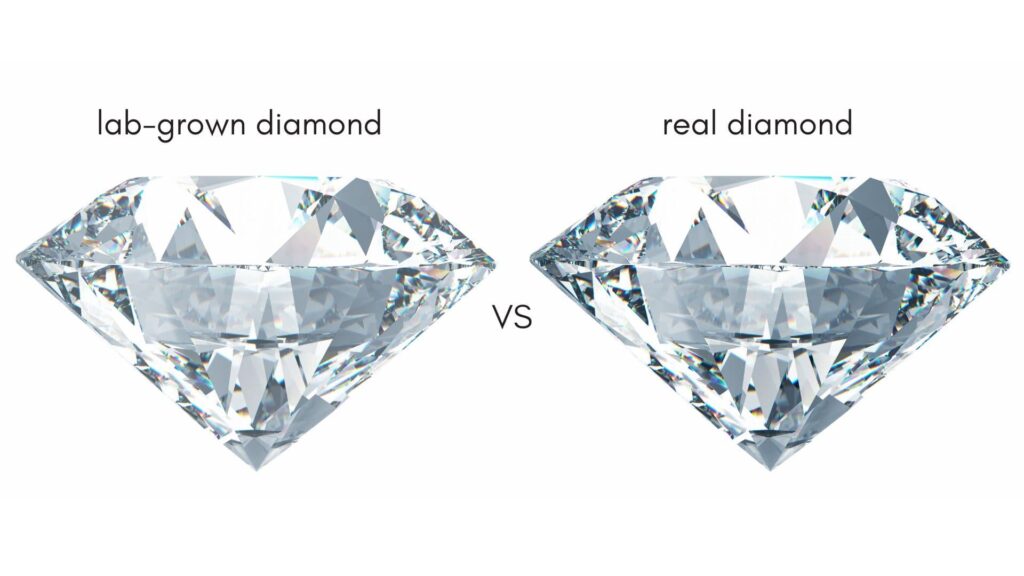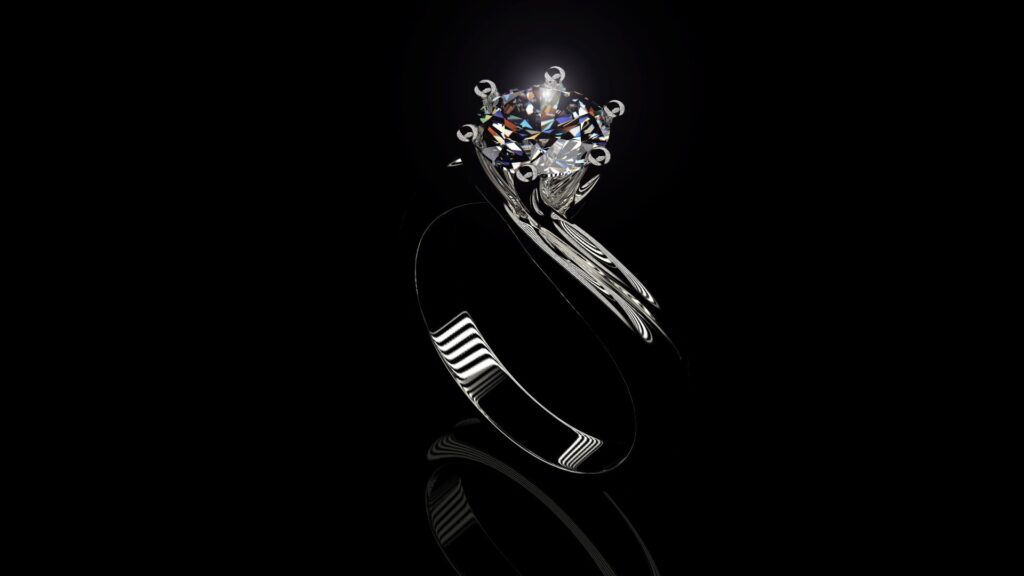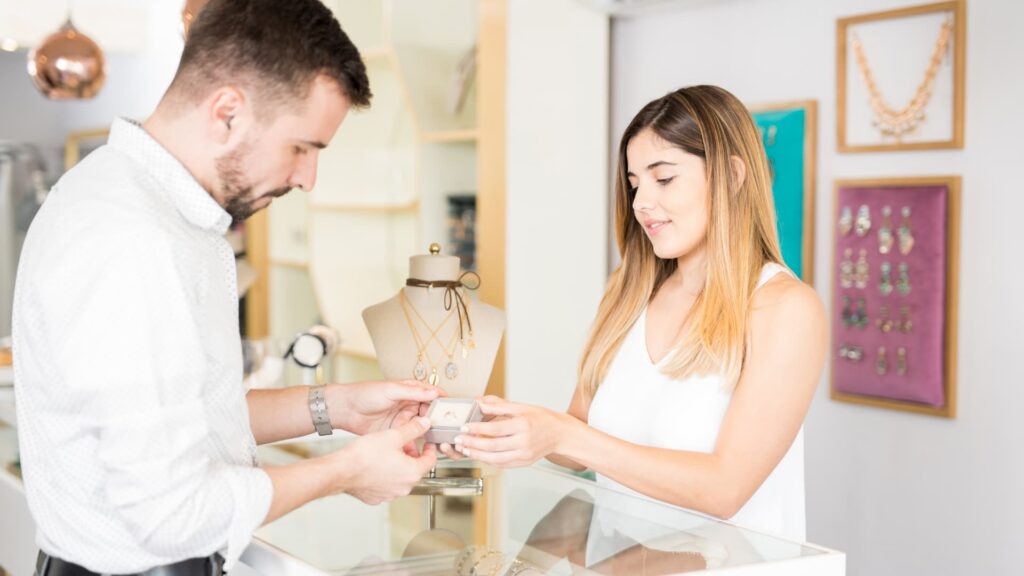Diamonds are one of the most coveted gemstones in the world, known for their beauty, rarity, and symbolic value.
But have you ever wondered about the differences between lab-grown diamonds and real diamonds?
Well, let me break it down for you!
In this article, I will explore the differences between lab-grown and mined diamonds. I will also highlight the factors consumers should consider when choosing between the two.

What Is a Lab-Grown Diamond?
A lab-grown diamond, also called a synthetic or cultured diamond, is a man-made alternative to natural diamonds.
These diamonds are created by mimicking the extreme heat and pressure conditions within the Earth’s crust.
It allows the growth of a crystalline structure identical to that found in natural diamonds.
Unlike natural diamonds, lab-grown diamonds are produced under highly controlled laboratory conditions. This ensures there are no impurities in their mined counterparts.
They are chemically and physically indistinguishable from natural diamonds. It possesses all its desirable qualities, such as hardness, durability, and brilliance.
This sustainable and ethical method of creating diamonds has become increasingly popular over the years for its affordability and environmentally friendly nature.
Types of Lab Grown Diamonds
There are two types of lab grown diamonds based on the process through which they are created. Let us compare the two below.
Chemical Vapour Deposition (CVT)
CVT diamonds are a sustainable and ethical alternative.
These diamonds are grown using advanced technology that replicates the natural diamond formation process.
It results in a product that is chemically, physically, and optically indistinguishable from mined diamonds.
The CVT production method ensures no human rights violations or environmental damage occur during the creation of these diamonds.
This makes them an excellent choice for consumers who value eco-friendly and socially responsible products.
Additionally, lab-grown diamonds are cost-effective compared to their mined counterparts. It provides a more accessible option for consumers who want high-quality diamond jewelry without breaking the bank.
In conclusion, CVT lab-grown diamonds offer a win-win solution by providing excellent quality at affordable prices while ensuring sustainability and ethical sourcing practices.
High-Pressure High-Temperature (HPHT) Diamonds
HPHT lab-grown diamonds are synthetic diamonds developed in artificial, controlled conditions.
It simulates the high-pressure and temperature environment required for the natural diamond formation process.
These diamonds are created using specialized machines. It takes a small diamond seed and rapidly applies extreme pressure and high temperatures.
This causes carbon atoms to crystallize into a new, larger diamond.
The resulting diamonds are chemically and physically identical to natural ones, making them an ethical and eco-friendly alternative to mined stones.
Moreover, these lab-grown diamonds often have fewer impurities than their natural counterparts, producing a higher-quality gemstone with greater clarity.
HPHT lab-grown diamonds continue to grow in popularity as consumers become more conscious of their impact on the environment.
How Are Natural and Lab-Grown Diamonds Different?
Natural diamonds are formed from carbon. When carbon atoms deep inside the earth’s mantle are put under extremely high pressure and temperature, they combine with each other in a symmetrical structure that creates a diamond.
They can be mined only in certain parts of the world, so their supply is limited, making them expensive.
Lab-grown diamonds use certain techniques to replicate the same pressure and temperature conditions in a controlled environment at a much quicker pace.
The most common methods used are High-Pressure High Temperature (HPHT) and Chemical Vapor Deposition (CVD), as mentioned earlier.
While both types of diamonds have identical physical and chemical properties, lab-grown diamonds are eco-friendly and ethically sourced.
They don’t require extensive mining that can harm ecosystems, and they rely on fair labor practices.
Additionally, when it comes to price, lab-grown diamonds are cost-effective compared to natural ones, with some costing 30% less without any compromise in quality or beauty.
Price
The price difference between the two varieties of diamonds is a subject of much debate in the diamond industry.
Natural diamonds can only be created under the earth’s surface, which means there is a limited supply of them.
Lab grown diamonds are made in science labs, so we can make as many as we want.
As a result, naturally occurring diamonds are rarer and more valuable than their synthetic counterparts.
However, advances in technology have allowed for larger and higher-quality lab-grown diamonds to be produced at a lower cost than natural diamonds.
Additionally, concerns about ethical sourcing practices in the diamond industry have led some consumers to prefer lab-grown diamonds, further driving down their prices.
The price difference between natural and lab-grown diamonds ultimately depends on factors such as size, quality, and market demand.
But as technology continues to improve and consumer preferences evolve, this gap will likely continue to narrow.
Durability
Natural diamonds are created through extreme pressure and heat beneath the earth’s surface over millions of years.
Lab-grown diamonds, on the other hand, are created using advanced technologies that replicate the same process as natural diamonds but within a shorter period.
Despite their similarities in composition, there are subtle differences in their durability attributes.
Natural diamonds tend to have higher grade ratings, and being untouched by human intervention makes them harder to structure than their laboratory counterparts.
Moreover, they score higher on Moh’s hardness scale, which determines resistance to scratching or chipping.
Lab-grown diamonds can offer greater robustness compared to those mined from the earth.
If given proper care, natural diamonds remain a more coveted option due to their long-lasting quality and the exclusivity factor derived from their rarity in nature.
Resale Value
Natural diamonds are created over millions of years in the earth’s crust under high pressure and temperature, making them scarce, precious, and valuable.
Their lab-grown diamonds are produced in a matter of weeks using advanced technology, making them more affordable than natural diamonds but less valuable in terms of rarity.
Furthermore, natural diamonds receive certificates from organizations like GIA that indicate their quality and value. Lab-grown diamonds receive synthetic diamond reports that can impact their resale value negatively.
Finally, natural diamonds are associated with emotional and romantic connotations that add sentimental value to them.
Therefore, even though both choices have merit depending on individual preferences and budgets, it’s critical to understand the potential difference in resale values.
Color & Clarity
There is a significant difference in the color and clarity of natural and lab-grown diamonds.
Natural diamonds are formed deep within the earth’s mantle under intense heat and pressure, which results in unique characteristics. This can set them apart from their lab-grown counterparts.
These diamonds often contain impurities or mineral inclusions that provide different colors or clarity grades.
In contrast, lab-grown diamonds are created using advanced technology to replicate the same conditions as diamond formation with fewer impurities present, resulting in higher clarity levels.
The advantage of lab-grown diamonds is the ability to control and replicate their color and clarity precisely.
Understanding these differences is crucial for consumers when choosing between natural and lab-grown diamonds, as these factors can affect prices significantly.
Ultimately, both natural and lab-grown diamonds have their respective advantages, depending on what you’re looking for.
It comes down to personal preference and budget constraints.
Also read: Glow In Dark Lab Diamonds and How to See Phosphorescence
Ecological Impact: Mining vs Lab Creation
Mining and lab creation have vastly different ecological impacts.
Mining often involves the destruction of natural habitats, the contamination of water sources, and the release of toxic chemicals into the environment.
This can have devastating effects on local ecosystems, including changes in species composition and the loss of biodiversity.
On the other hand, lab creation relies on developing products via synthetic methods without relying on raw materials from nature.
This approach has a much smaller ecological footprint since it does not involve extracting resources from the earth.
However, there are still environmental concerns associated with lab creation, such as energy consumption and waste generated during production processes.
Ultimately, both mining and lab creation have their advantages and disadvantages in terms of ecological impact.
It is important to evaluate these factors when deciding which approach to take to minimize environmental harm as much as possible.
Lab Grown Diamonds: Myths & Facts
Hopefully, by now, you have understood that there is not much difference between the two varieties of diamonds.
In fact, lab-grown diamonds are ecologically sensitive and good for the environment.
However, there are still a lot of myths pervading these stones, which cause immense harm to their reputation as well as their value.
Let us address some of these myths below and give you the real picture.
Myth 1: Lab grown diamonds aren’t real; they are synthesized
Despite common misconceptions, lab-grown diamonds are just as real as their mined counterparts.
While it’s true they are created through a process of synthesis, this does not detract from their authenticity or value.
The technology used to grow diamonds in a laboratory setting has advanced to such a degree that it is now possible to replicate the same conditions that produce natural diamonds beneath the earth’s surface.
Through this process, lab-grown diamonds exhibit identical chemical and physical properties to those that have naturally occurred for years within diamond mines.
Even expert gemologists find it difficult to distinguish between lab-grown and mined stones without sophisticated testing equipment.
Whether a diamond is formed in nature or produced in a lab, what matters most is its beauty and emotional significance to those who cherish it.
Also read: Lab-Created Salt and Pepper Diamonds
Myth 2: All lab grown diamonds are small and therefore don’t carry any value
It is a common perception that all lab-grown diamonds are small, but this is not entirely accurate.
Lab-grown diamonds can be produced in a wide range of sizes and qualities, from small, melee stones to large, high-quality gems.
The technology behind diamond synthesis has advanced significantly in recent years, allowing for the creation of larger and higher-quality diamonds than ever before.
Additionally, lab-grown diamonds offer greater flexibility in terms of customizing the size and shape of the stone compared to natural diamonds.
While it is true that smaller lab-grown diamonds may be more prevalent and affordable due to production efficiencies, consumers can find options for larger stones if they are willing to invest.
Ultimately, the size of a lab-grown diamond will depend on its intended use and the preferences of the consumer.
Myth 3: Lab grown diamonds cannot be graded, so there is no way to determine their quality
The myth that there is no grading for lab-grown diamonds is not entirely accurate.
While it is true there is no universal grading system in place for lab-grown diamonds, the Gemological Institute of America (GIA) has developed a specific set of guidelines for these stones.
The GIA’s Diamond Grading Report includes information on the diamond’s carat weight, clarity, color, and cut, just as it would with a natural diamond.
Furthermore, many reputable jewelers and gemologists have adopted their own grading systems to ensure accuracy and consistency when assessing lab-grown diamonds.
While lab-grown diamonds may differ from natural diamonds in terms of their origins, they possess the same physical and optical properties as natural diamonds and can be graded.
Keeping up with emerging technologies and advancements within the industry will be critical as this product category continues to develop.
Find out everything about D vs. F Color Diamond.
Wrap Up
In conclusion, the debate between lab-grown diamonds and real diamonds ultimately comes down to personal preferences and values.
While real diamonds have the prestige of being natural and unique, lab-grown diamonds offer an eco-friendly alternative with guaranteed ethical sourcing.
Of course, naturally occurring diamonds maintain their price supremacy both in the primary and secondary markets.
This is a shame, because their lab grown counterparts are in no way inferior to them.
Moreover, it’s important to consider the environmental impact and working conditions associated with mining natural diamonds versus the faster production process of lab-grown diamonds.
Finally, consumers should be aware that both options are fairly expensive, so you should never buy without understanding the quality of the product through its 4Cs.
Regardless of which type of diamond you choose, both are symbols of love and commitment that will last a lifetime.






